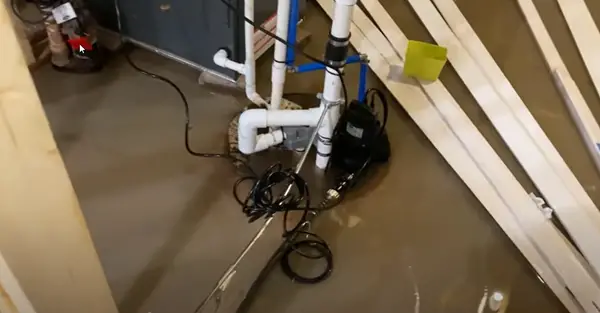Water backup and sump overflow coverage are two different things that are combined by insurance companies into one policy endorsement.
When I worked in a small city water and sewer department, we had three pumps that moved the sewage uphill from the city to the sewage ponds. If those pumps failed for any reason the underground sewer pipes would fill up and then sewage would backup into people’s basements.
If you consider how much damage fires, severe thunderstorms, tornadoes, hurricanes, mud slides, and earthquakes create, it is entirely possible that sewer systems could fail. Unfortunately, homeowners’ insurance and flood insurance does not cover water backup and sump overflow.
Also, the city is not responsible for your damages. Does that answer your question “Do I need water backup and sump overflow coverage?”
Table of Contents
What Is Water Backup and Sump Overflow Coverage?
One of the worst things that can happen in your home is when the basement fills up with a foot of raw sewage. Even though it is sewage, for insurance purposes it is called “water backup”.
On the other hand, “sump overflow” refers to water overflowing out of the sump pit and making the basement wet. Typically, “sump overflow” happens when the sump pump fails for some reason.
That could be from losing electric power, or more water entering the sump pit than the pump can handle. It could also be a mechanical failure of the pump. Such as the impeller being blocked by a rock or the motor burning out.
This man’s basement was flooded because of more water entering the basement than the sump pump could remove. He needed a sump overflow coverage endorsement on his homeowner’s insurance policy.
So, if the sewer drain backs up or the sump pump pit overflows, you need “water backup and sump overflow” insurance coverage to pay for fixing the damages.
“Water backup coverage” is also called “sewer” or “sump pump backup coverage” which is an optional endorsement that can be added to a homeowners insurance policy.
It provides protection in case of water damage resulting from issues like sump pump malfunctions, drain overflows, or sewer backups.
However, it’s important to note that water backup coverage does not include damage from floods. You would need to purchase a separate flood insurance policy for that.
What Does Water Backup and Sump Overflow Coverage Include?
I am not an insurance expert but I think I can sort out the complexities for you.
The water backup and sump overflow policy will cover the cost to clean and fix your home, and everything damaged by the water up to your policy limits. More on that later.
However, if the insurance company finds out that you haven’t had the sump pump serviced and maintained regularly, they won’t pay for damages.
First, sewer backup coverage is the same thing as water backup coverage. They are NOT the same as flood insurance. Also, flood insurance will not cover damages from water backup and sump overflow.
Also, a separate policy endorsement is needed to fix a broken sump pump. That is called an “equipment breakdown” endorsement.
If the sewer drain backs up because of a flood in the neighborhood, many insurance policies will not cover the sewer back up damages. Some companies do cover that, but you better check with your insurance agent.
Example #1. During a thunderstorm the electric power goes out and the sump pump stops working. So, the sump pit overflows and wets the carpet. That would be covered by the sump overflow coverage endorsement.
Example #2. Many cities have a combined sewer and street drainage system. That is where the storm water flows off the street into the sewer pipes. If there is more water than the pipes can handle, that water will start to back up into basement drains. That damage would be covered by the water backup coverage but not flood insurance.
Example #3. The sump pump is old and breaks down for some reason while you are on vacation. So, the sump basin overflows and floods the basement. If you had the sump pump serviced recently, the insurance company will likely pay for damages. However, if you can’t prove the pump was serviced, you would be out of luck.
Example 3.5. An “equipment breakdown” endorsement is needed to have the broken sump pump fixed.
Example #4. The sump pump is new and the electric power goes out while you are on vacation but you have a battery backup sump pump. If the backup sump pump can handle the amount of water coming in, everything is fine. That is until the battery dies. If water damage happens after the battery dies, you would be covered by the policy.
Note: if you don’t even own a sump pump and water comes in from outside of the house, then you need flood insurance.

How Much Water Backup and Sump Overflow Coverage Do I Need?
Add up the cost of everything in the basement. Including furniture, appliances, toys, and carpeting. That is the bare minimum. You should add in the cost of removing and replacing sheetrock walls, the furnace, and water heater. That might add up to $25,000 or more.
How Much Does Water Backup and Sump Overflow Coverage Cost?
Among various insurance companies, it seems that the basic water backup and sump overflow coverage amount is $5,000. The price varies but is approximately $50. For each additional $5,000 in coverage, you would pay about $30. So, a $25,000 policy would be $170 – $250.
Final Thoughts on: Do I Need Water Backup and Sump Overflow Coverage?
Answer this question: Can you afford to replace everything in the basement? Including the furnace, water heater, carpeting, furniture, and sheetrock walls? How about just one or two of those items? Well, that is why you need water backup and sump overflow coverage added to your homeowner’s insurance policy.
Two other insurance policy endorsements to buy are “flood insurance” and “equipment breakage” coverage. Each of these policy endorsements do not cover what the others cover. So, you need all three.
In conclusion, considering the potential for water damage from backed-up drains or failed sump pumps, I personally find it worthwhile to invest in water backup and sump overflow coverage for my home. By understanding the coverage and its limitations, you can make an informed decision about how much insurance is necessary for your specific situation.

Author at Best Sump Pumps
The first time I helped to install a drain tile and basement sump pump system was 1978.
Since then I have worked for a city water utility where I worked with and maintained pumps.
My rental properties and personal homes all needed sump pumps.
As a modular home dealer/builder, those new homes needed sump pumps.
I put that experience to good use by providing reliable, useful, and practical advice on buying, using, and maintaining sump pumps.
